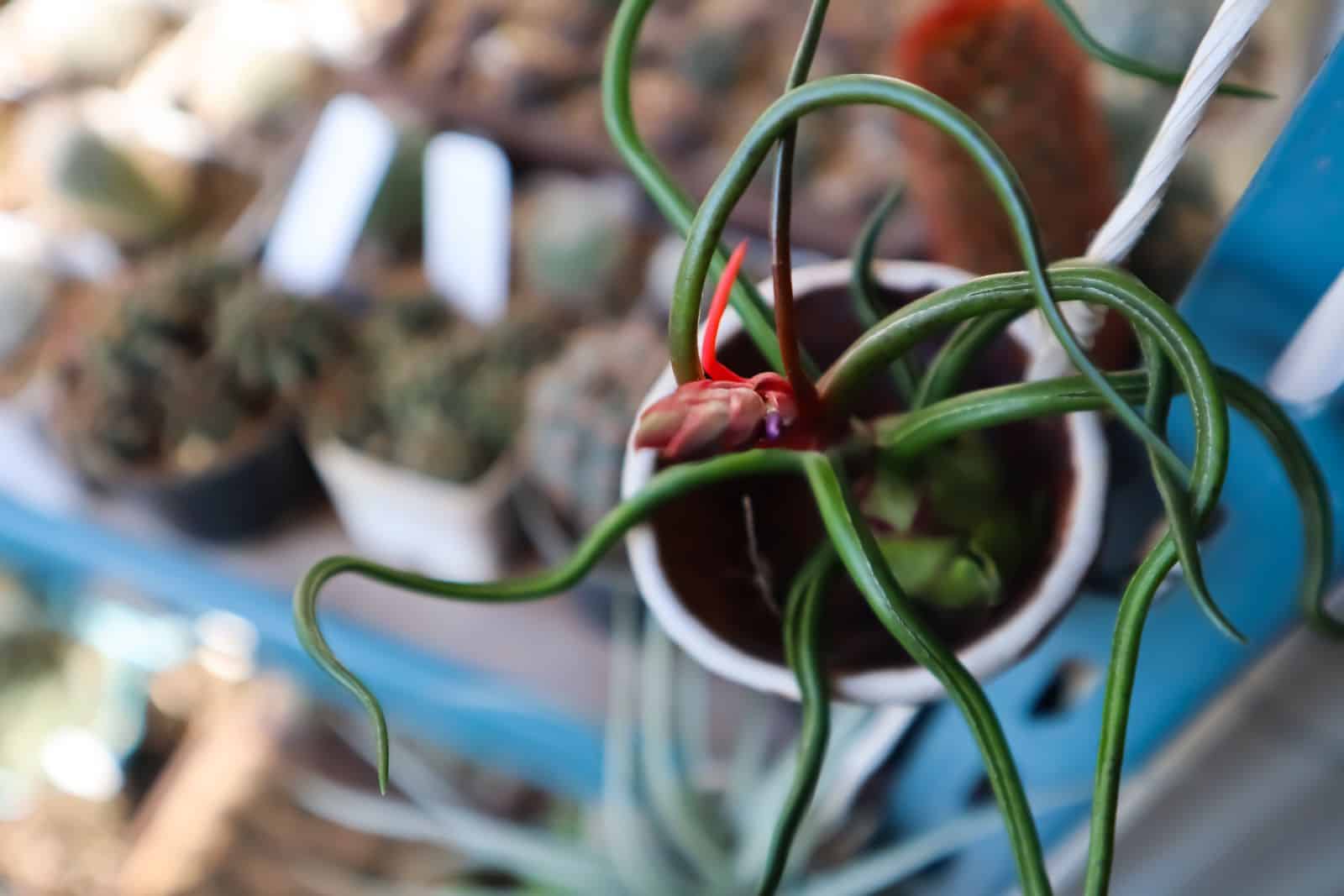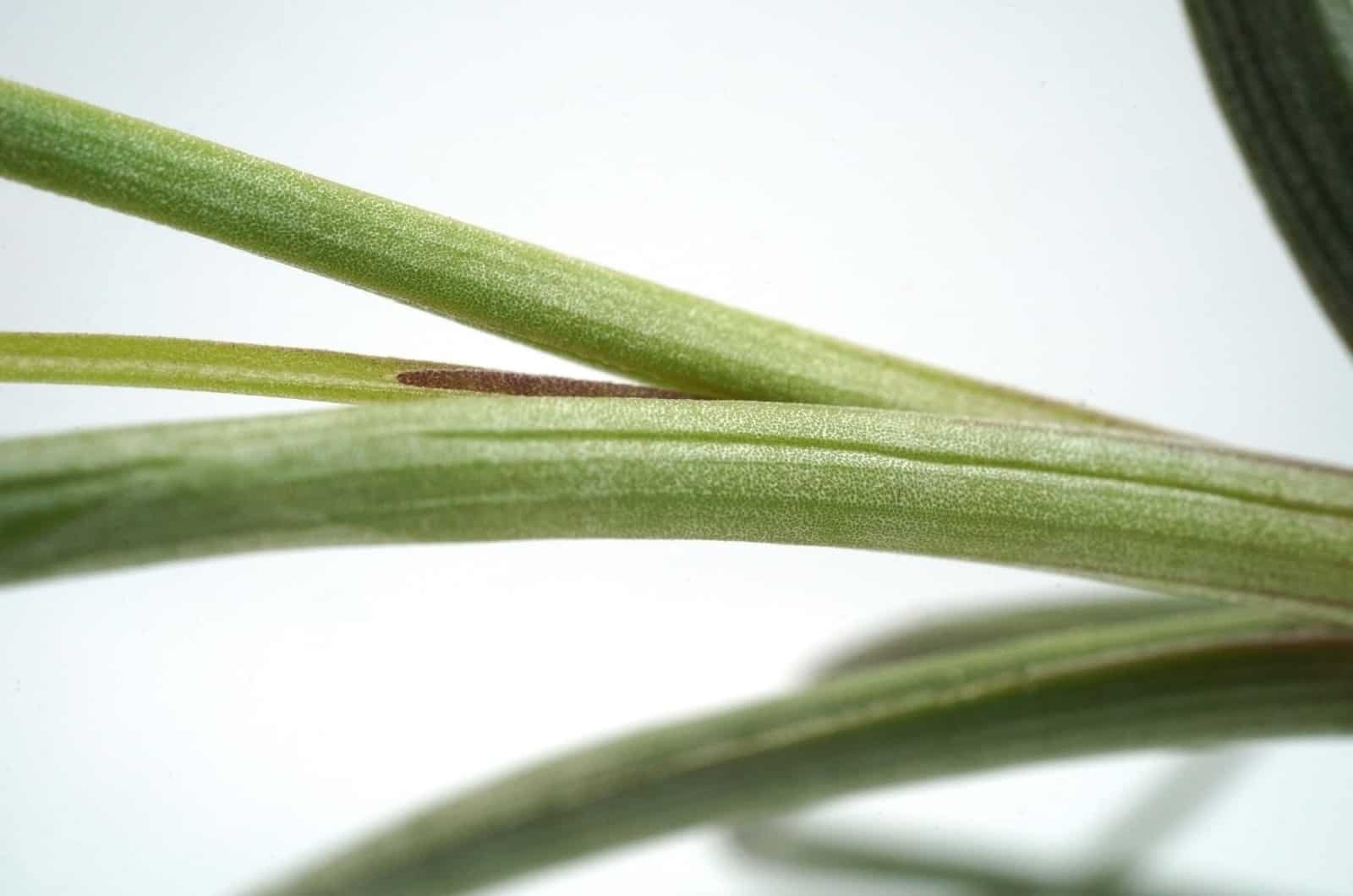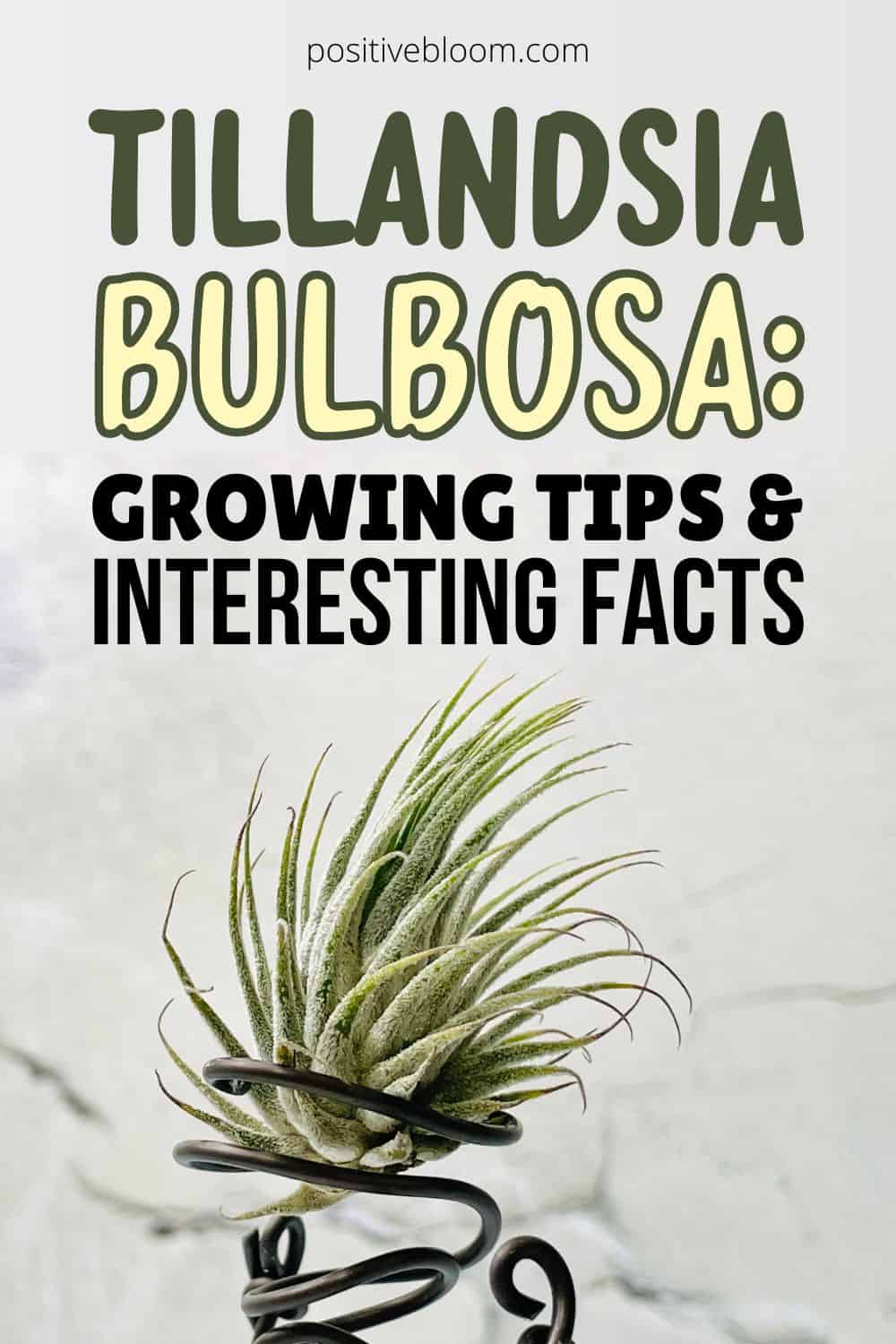The Tillandsia bulbosa isn’t something you see every day, but it can add so much to your interior design, especially if you plant it in a terrarium.
It is an epiphyte, so growing it in an enclosed glass container might seem a bit weird at first. However, this article is full of tips for planting this variety, and you’ll have no issues incorporating it into your home decor.
Furthermore, it is low-maintenance and perfect for beginners. (Although, we’ll still let you in on some of our plant care secrets!)
We’ll also discuss some common issues you may encounter while taking care of this plant, some facts about T. bulbosa, and even some other popular tillandsia types.
Before we get to all that, let’s examine this bulbous plant in more detail:
[table id=309 /]
How To Plant The Tillandsia Bulbosa
One of the key parts of planting the bulbosa air plant is choosing the right growing medium.
These varieties cannot grow in soil, but that’s even better as it makes this plant easier to care for.
You can place some decorative materials into the terrarium, such as driftwood, decorative stones, twigs, moss, or even some marbles.
Now, all that’s left is to add your air plant to the vessel, just make sure to choose the size ideal for your container – neither too big, nor too small – so that it can fit into its new home nicely.
Tillandsia Bulbosa Care Guide
The care guide for this bulbous air plant is extremely simple, you just have to spray it with water from time to time, and that’s it!
However, there are a few other things you should be mindful of, such as the location, temperature, and humidity, and we’ll discuss these elements in the sections below.
Light Requirements
The T. bulbosa prefers locations where it can bask in indirect light, but a few hours of early-morning or late-afternoon sunlight won’t do them much harm.
It is much more resilient than other tillandsia varieties, so you’ll have more freedom in deciding where you want to place it.
You can even pair it with other light-loving plants that live in terrariums, such as orchids and succulents. The care guide for the echeveria flower is relatively simple, and you’ll have no difficulties growing this plant alongside your air plants. They’ll all look impressive together in a glass vessel!
Water And Humidity
Water is essential for all plants, and this species is no different. However, it is much simpler to irrigate the Tillandsia bulbosa than other plants because it doesn’t really use its roots to uptake water.
Instead, air plants contain trichomes, which are hair-like structures that grow on the surface of their leaves, and it’s these trichomes that absorb moisture from the air.
This plant doesn’t have many of these structures in its native habitat as it’s quite humid, and the T. bulbosa doesn’t have to struggle to get more moisture.
However, the surface of this plant brims with trichomes in more arid regions where water is scarce. It is precisely these tiny structures that give this bulbosa its signature silvery look.
Finally, you can mist your plants every other day to ensure proper hydration if you keep them in open terrariums.
Plants grown in closed containers require less frequent spraying as water cannot escape the glass. Too much moisture can lead to rotting in extreme cases.
If your region is somewhat dry, you should water these plants directly, which involves submerging the bulbous base of these plants in water a couple of times a week, or soaking them for a few hours once a week to ensure they get enough moisture.
You must shake off the excess water as it can cause rot and kill your plant.
Humidity
This plant loves medium-to-high humidity, and anything above 50% is perfect. I’ve been asked many times whether humidity trays work for plants, and the answer is not that simple.
However, they are quite reliable for air plants as they aren’t very tall, and moisture that evaporates from the tray can reach the leaves of the tillandsia bulbosa.
Pebble trays can replace misting entirely, but you should still soak your plants occasionally, especially during the hotter months when your plants transpire more.
Spraying your plants with water every couple of days (misting) is a great way to consistently raise humidity.
Temperature
These plants aren’t that demanding when it comes to temperature, and anything between 55-90°F is fine.
However, T. bulbosa does prefer to be kept at room temperature, so bear that in mind when adjusting the thermostat.
You shouldn’t maintain the same temperature during both day and night. These plants grow slower if kept at room temperature all the time, so ensure that the night temperature is a bit cooler than the temperature during the daytime.
But don’t let the temperature ever fall below 55°F (even in the winter months), as that would be detrimental to your plant.
Soil And Fertilizer
The Tillandsia bulbosa cannot be grown in soil as it retains moisture and would lead to the rotting of the bulbous base.
Instead, you can plant, or rather place this species on some other materials such as stones, twigs, shells, etc., to make the terrarium look more appealing (and your plant won’t mind some company).
The good news is that you don’t have to fertilize this plant at all, but if you find yourself at the checkout with some tillandsia fertilizer, you don’t have to return it.
You can spray some of this plant food once or twice a month during this plant’s growing season or even soak it in water with some added fertilizer.
However, frequent feeding is actually harmful and may kill your plant, so don’t overdo it.
Repotting
An amazing thing about these plants is that you never have to repot them.
However, you can change the pot if you have redecorated your space and the plants’ current container doesn’t fit into the decor.
There are a couple of potting choices, and glass terrariums are the most common. However, you can always display these plants on some magnificent rocks, stones, or even pieces of driftwood.
Finally, you can use pots for this bulbosa if you want, simply fill the container with some small stones or bark and plant the T. bulbosa in it.
Propagation
Tillandsia varieties are relatively easy to propagate, and there are a couple of ways you can multiply these plants to enlarge your air plant collection or give them as gifts.
The most common ways to propagate the Tillandsia bulbosa are by sowing the seeds and harvesting pups or offsets from the parent plant.
We’ll discuss both techniques in the sections below, so your seeds or tiny pups won’t go to waste.
However, we need to clarify one thing before moving on to propagation, and that is “Which water to use?”. There’s a never-ending debate about which water is best for your plants.
We can only say that distilled water (or tap water left in the air for about 24 hours so that the chlorine can evaporate), are probably the best choices as they don’t contain any harmful substances that may hinder your plant’s growth or cause some health issues.
Sowing T. Bulbosa
Here is our step-by-step guide for sowing tillandsia seeds:
Step 1. Take the seeds out of the seed pods, and if they are brown, soak them in a container filled with lukewarm water for about 2-4 weeks. Close the vessel, but puncture some holes in the lid.
If the seeds already contain green nubbins, you don’t have to soak them.
Pro tip: Open the lid every couple of days to allow air circulation.
Step 2. Carefully separate the seeds.
Step 3. Place the seeds on a growing substrate, such as sphagnum moss, jute fabric, velcro sheet, etc. The material needs to retain moisture to allow the seeds to further grow and develop, but it shouldn’t be too soggy as that can lead to rotting.
Step 4. Place the seeds in a bright spot and spray them whenever they seem dry. Always allow them to dry out between watering because too much moisture can lead to mold on the growing medium.
If you notice that the substrate has become moldy, move the seeds onto a fresh medium and mist them less frequently.
The growth will be slow for the first couple of years, but will speed up afterward.
Here are some more tips about propagating this air plant through seeds:
Propagation Through Offsets
Propagating T. bulbosa through the mother plant offsets is probably the most common way of multiplying these plants.
We’ll describe this process in detail in our guide below:
Step 1. Choose the healthy plant you wish to propagate, remove it from its current home, and soak it in water until fully moisturized.
Step 2. After the plant hydrates, remove it from the water and shake off the excess.
Step 3. Place the plant on a clean and dry sheet, and spread the foliage until you can see the baby pups around the plant’s base.
Step 4. Remove and separate the pups, and return the mother plant back to its terrarium (or anywhere else you keep it).
Step 5. Put the pups in a new terrarium, place the container in a bright spot, and mist them frequently.
It can take up to 4 years before your pups develop into established air plants, so you should practice patience if that’s not one of your virtues already!
Cleaning And Pruning
These plants are incredibly easy to care for as you don’t have to clean or prune them. Actually, that’s not entirely true; you should clean them.
However, these plants get cleaned every time you mist them, so you don’t have to put in extra work to make sure that they’re thriving.
Common Issues
Unlike other plants, the Tillandsia bulbosa is fairly resistant to pests and diseases because it doesn’t grow in soil. Therefore, root rot and pest infestations are quite uncommon, but not entirely impossible.
Below you can read about some of the most frequent pests and diseases that may afflict this plant, as well as some tips for dealing with them.
However, if you want to avoid these issues, ensure that your plant gets enough sunlight and that you don’t overwater it.
Pests
Pests that commonly attack this plant include scales, spider mites, and mealybugs. Thankfully, these infestations aren’t very common.
If some bugs lay their eggs and colonize your T. bulbosa, you can simply pick them off one by one if the infestation isn’t too large.
However, for larger swarms of these nuisances, you should use horticultural oils or even turn to pesticides for air plants.
Diseases
The most common disease that afflicts this bulbous air plant is root rot. It is deadly in most cases and usually caused by excessive watering.
Ensure you don’t soak this plant in water too frequently, and always allow the foliage to dry before misting it.
Root rot causes soggy, mushy, and soft roots at the base of the plant. The only thing you can do is try to remove the infected parts, but if the disease has spread, you might need to throw the entire plant away.
More About The Tillandsia Bulbosa
This air plant is quite interesting, and there are lots of cool things to discover about it.
For instance, it is an epiphyte, but you can grow it in a terrarium where you certainly won’t stake it on a moss pole.
It also looks like some sort of a sea creature or an alien with its curly leaves wriggling away from the base like snakes.
(Come to think of it, it does remind me of Medusa – it only lacks the power to petrify you with just one look!)
Below you will discover more about this plant’s origins and background, as well as some of the main features that make it alluring to growers.
History And Origin
The Tillandsia bulbosa belongs to the family Bromeliaceae, or rather Bromeliad. Bromeliads are quite popular and have even found their way onto a list of plants with red leaves, so it’s not surprising that this variety has only grown in popularity in recent years.
The reason it was named “tillandsia” is very interesting (I get the bulbous part). Well, I researched it and discovered that Carolus Linnaeus, a Swedish botanist, physician, and naturalist, gave it this name to honor Elias Tillandz, another Swedish doctor.
Main Features
One of the most striking characteristics of this plant are its dark green leaves, which turn violet when this plant is ready to flower.
Unfortunately, you can enjoy these red tubular flowers only once during the plant’s lifetime. This air plant blooms from early spring to mid-summer, and the non-scented inflorescence is about 1-3 inches long.
However, not everything’s dark!
The mother plant also grows baby pups, and each of them can bear its own blossoms once its time comes. The parent plant will grow 2-8 pups before it dies, and you’ll have many things to look forward to.
The plants are usually 6-12 inches tall, and their leaves are shaped into rosette arrangements.
Popular Tillandsia Varieties And Cultivars
The Tillandsia bulbosa has a couple of mesmerizing cultivars that are worth examining.
All these options make excellent companions, and their colors flawlessly complement the space around them.
Tillandsia Bulbosa Guatemala
This small Guatemalan variety has serpentine green leaves characteristic of tillandsias and is one of the cultivars we’re all used to seeing.
The foliage is spiky, and the plant produces red flowers, which makes it an attractive addition to your indoor garden.
Tillandsia Bulbosa Belize
This cultivar also has twisted and pointy leaves, but they are much larger than in the Guatemala variety.
The leaves are usually green, but they can turn bright red once the plant gets ready to blossom and produce purple flowers.
Tillandsia Ionantha
This variety also belongs to the genus Tillandsia, but it differs significantly from the ones we’re used to. This grass-like variety also has different cultivars, so its foliage may be fire-red, blue-green, or even grayish.
Tillandsia Caput Medusae
This plant truly resembles Medusa’s head with its pointy, snake-like leaves. The foliage is usually green, but it may have purple margins near the base. Also, if it’s grown in a more arid region, dense trichomes may give it an irresistible silvery appearance.
It produces tubular flowers of many different colors, so don’t be surprised if you find vivid cherry red and yellow parts with violet and white blossoms.
You Asked Us
There are some more things you need to know about the genus Tillandsia and about the Tillandsia bulbosa in particular.
Therefore, we decided to answer a couple of r your most frequently asked questions.
Let’s begin!
What is the lifespan of a Tillandsia?
Plants from the genus Tillandsia usually live between 2-5 years. However, they are considered perennials, which means they live more than two years in most cases.
The lifespan mainly depends on the variety you grow and its growing conditions, so keep it in a well-lit spot and well hydrated in order to prolong its life.
What is the difference between Tillandsia and air plants?
Technically, air plants belong to the genus Tillandsia, so there’s no real difference between these two terms.
There are different varieties of Tillandsia, and they do differ in size, shape, and color, but the genus remains the same.
Is the Tillandsia bulbosa a houseplant or an outdoor plant?
T. bulbosa is actually an outdoor plant because its native habitat is outdoors, although you can grow it indoors without any problems.
In fact, if not grown in its natural habitat, you should move it indoors just to be on the safe side. This plant needs warmer temperatures, and anything below 55°F can be harmful to it, so you should move it indoors once the temperatures start getting lower.
However, if you live in a tropical or subtropical climate, you can safely grow them outdoors; just plant them in a spot where direct sunlight won’t harm them, such as beneath a tree, in the crooks of tree branches, or in some other sheltered area.
Wrapping Up
This article brought you everything you need to know about the Tillandsia bulbosa. We included some planting tips, as these plants don’t grow in traditional mediums, and some care tricks you can implement in order to prolong this plant’s life.
This variety is pretty resistant to plant issues such as pest infestation and infections. However, it is always possible that something may stress your plant (such as too much moisture around its leaves and roots), and bugs find easy prey in weak plants they can drink sap from.
That’s why we also included some ways of getting rid of these nuisances and also examined ways to avoid root rot (as it is fatal in most cases).
Furthermore, we presented some interesting facts about this air plant, such as where its name comes from, to which plant family it belongs to, and what its main features are.
We also examined some attractive cultivars and other varieties you might want to grow.
Enjoy these amazing live decorations, and until next time!
Like this pin? Share or pin it for later!




